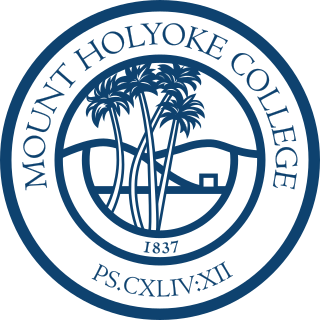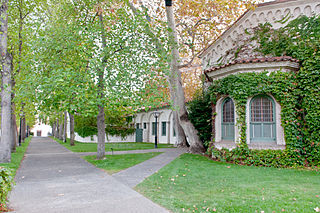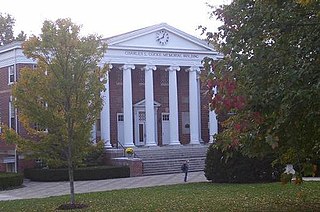
Mount Holyoke College is a private liberal arts women's college in South Hadley, Massachusetts, United States. It is the oldest member of the historic Seven Sisters colleges, a group of historically female colleges in the Northeastern United States. The college was founded in 1837 as the Mount Holyoke Female Seminary by Mary Lyon, a pioneer in education for women. Mount Holyoke is part of the Five College Consortium in Western Massachusetts.

The University of Connecticut (UConn) is a public land-grant research university system with its main campus in Storrs, Connecticut. It was founded in 1881 as the Storrs Agricultural School, named after two benefactors. In 1893, the school became a public land grant college, then took its current name in 1939. Over the following decade, social work, nursing, and graduate programs were established. During the 1960s, UConn Health was established for new medical and dental schools. UConn is accredited by the New England Commission of Higher Education.
The Seven Sisters are a group of seven highly prestigious private liberal arts colleges in the Northeastern United States that are historically women's colleges. Barnard College, Bryn Mawr College, Mount Holyoke College, Smith College, and Wellesley College are still women's colleges. Vassar College became coeducational in 1969, and Radcliffe College was absorbed in 1999 by Harvard College and now offers programs in advanced study.

The University of Bridgeport is a private university in Bridgeport, Connecticut. The university is accredited by the New England Commission of Higher Education. In 2021, the university was purchased by Goodwin University; it retained its own name, brand, and board of trustees.

The University of Hartford (UHart) is a private university in West Hartford, Connecticut. Its 350-acre (1.4 km2) main campus extends into neighboring Hartford and Bloomfield. The university is accredited by the New England Commission of Higher Education.

Barber–Scotia College is a private unaccredited historically black college in Concord, North Carolina. It began as a seminary in 1867 before becoming a college in 1916. It is affiliated with the Presbyterian Church (USA).

Women's colleges in higher education are undergraduate, bachelor's degree-granting institutions, often liberal arts colleges, whose student populations are composed exclusively or almost exclusively of women. Some women's colleges admit male students to their graduate schools or in smaller numbers to undergraduate programs, but all serve a primarily female student body.
Trinity Washington University is a private Catholic university in Washington, D.C. The university was founded as Trinity College by the Sisters of Notre Dame de Namur in 1897 as the nation's first Catholic liberal arts college for women. Trinity was chartered by an Act of Congress on August 20, 1897. It became Trinity Washington University in 2004.

Chestnut Hill College is a private Catholic college in the Chestnut Hill section of Philadelphia, Pennsylvania. The college was founded in 1924 as a women's college by the Sisters of St. Joseph. It was originally named Mount Saint Joseph College.

Holyoke Community College (HCC) is a public community college in Holyoke, Massachusetts. It offers associate degrees and certificate programs, as well as a transfer program for students to earn credits for transfer to other colleges. It was the first community college established in Massachusetts, as it was founded by the city's school board in 1946, while others were subsequently chartered under state jurisdiction after 1960.

Manchester Community College (MCC) is a public community college in Manchester, Connecticut. Founded in 1963, it is the third-oldest of the twelve community colleges governed by the Connecticut State Colleges & Universities system (CSCU) and has graduated more than 23,000 students since the first class in 1965.
Edgewood College is a private Dominican college in Madison, Wisconsin. The college occupies a 55 acres (22 ha) campus overlooking the shores of Lake Wingra.
Sage College of Albany, SCA for short, was located at 140 New Scotland Avenue, Albany, New York, 12208. Along with Russell Sage College and the Sage Graduate School, it was one of the three colleges that made up The Sage Colleges. It was also home to Sage After Work, which offers a variety of bachelor's degrees in a format designed specifically for adult learners. It offered bachelor's degrees, with the largest programs being Visual Arts, Management and the interdisciplinary Law & Society. SCA students often took courses on the Russell Sage College campus in Troy, New York, or accelerated into one of the master's programs in the Sage Graduate School. 850 students were enrolled at SCA, and it shared approximately 150 faculty members with the other Sage colleges. About 66% of the student body were female. Since 2020, the former SCA is now Russell Sage's Albany campus.

Long Beach City College (LBCC) is a public community college in Long Beach, California, United States. It was established in 1927 and is divided into two campuses, the Liberal Arts Campus in Lakewood Village and the Pacific Coast Campus in central Long Beach on Pacific Coast Highway. It is the only college in the Long Beach Community College District.
The Mount Vernon Seminary and College was a private women's college in Washington, D.C. It was purchased by George Washington University in 1999, and became the Mount Vernon Campus of The George Washington University.
The following is a timeline of women's colleges in the United States. These are institutions of higher education in the United States whose student population comprises exclusively, or almost exclusively, women. They are often liberal arts colleges. There are approximately 35 active women's colleges in the U.S. as of 2021.

Women's colleges in the Southern United States refers to undergraduate, bachelor's degree–granting institutions, often liberal arts colleges, whose student populations consist exclusively or almost exclusively of women, located in the Southern United States. Many started first as girls' seminaries or academies. Salem College is the oldest female educational institution in the South and Wesleyan College is the first that was established specifically as a college for women, closely followed by Judson College in 1838. Some schools, such as Salem College, offer coeducational courses at the graduate level.

Women's colleges in the United States are private single-sex U.S. institutions of higher education that only admit female students. They are often liberal arts colleges. There are approximately 26 active women's colleges in the United States in 2024, down from a peak of 281 such colleges in the 1960s.
Thomas More College was a coeducational, undergraduate college of liberal arts and sciences that was open from the fall of 1964 until it merged with Fordham College at Rose Hill in 1974. It offered arts and science programs for women as well as programs, such as drama, for men that were unavailable at Fordham University, which, at that time, only admitted men into its undergraduate programs. While the undergraduate school of Fordham University only admitted men, many of Fordham's graduate schools, such as the School of Education, Graduate School of Arts and Sciences, Law School, College of Pharmacy and School of Social Service were coeducational. Thomas More College, however, provided women the opportunity to earn an undergraduate liberal arts degree.
Gregory Woodward is a former administrator of higher education. He was most recently the sixth president of the University of Hartford. He was also the twenty-second president of Carthage College.











